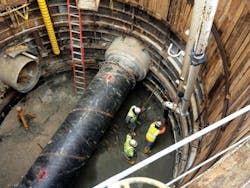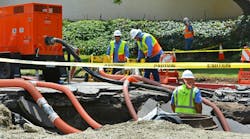Storage: Safe & Dry
To meet the urgent storm water management needs of neighborhoods in the nation’s capital, the District of Columbia Water and Sewer Authority (DC Water) needed a technical approach that combined existing historic facilities with new infrastructure. The McMillan Stormwater Storage Project not only provided an environmentally friendly solution that reduced capital costs, it also was managed under busy city streets to minimize disruption while providing flood protection and water quality benefits.
In the summer of 2012, four intense rainfall events caused combined sewage to exceed the capacity of DC Water’s 120-year-old collection system and flood the Bloomingdale and LeDroit Park neighborhoods of Washington, D.C. More than 200 property owners experienced basement flooding caused by sewer backups and overland flow. Surface flooding in the streets occurred at many locations, including a busy intersection where ponding levels approached 3 ft. Some portions of the collection system located within this chronic flood area do not have the capacity to convey storms with return frequencies beyond a two-year storm without flooding. The 2012 storms had return frequencies of five to 10 years.
Emergency Response
In response, DC Water and city officials initiated an emergency design-build project to alleviate chronic flooding in these neighborhoods. The design-build team of PC Construction and McKissack & McKissack was selected to create new underground diversion structures, storm water storage capacity and aboveground green infrastructure to alleviate the flooding. As the program management consultant for DC Water’s Combined Sewer Overflow Long Term Control Plan (LTCP) implementation, Greeley and Hansen provided preliminary engineering design services for the project, as well as final design for the green infrastructure elements. O’Brien & Gere provided program and construction management of the design-build contract.
The project scope featured the repurposing of an underground filter vault within the decommissioned McMillan Water Filtration Plant, originally constructed in 1904 by the U.S. Army Corps of Engineers as a slow-sand filtration system. The 3-million-gal below-grade storage basin would be connected to an existing 60-in.-diameter storm sewer in North Capitol Street through a new concrete diversion structure, which would redirect storm water into the basin during intense storms. Once the wet weather passed, the stored water would be released and conveyed through existing pipeline to DC Water’s Blue Plains Advanced Wastewater Treatment Plant.
One unique aspect of the project was the removal of the original filter sand from the 1-acre sand vaults. With a daily crew of two skid-steer loaders and three laborers, it took approximately two months to remove a total 3,600 cu yd of sand. Using existing ramps leading into the vaults, the skid-steer loaders removed the majority of the sand. Due to the concave nature of the floors and support structures, significant manual labor, using shovels and brooms, was required to complete the sand removal.
With the catacomb-like vault ready for use, work began on the 25-ft-deep diversion structure in North Capitol Street. A second 55-ft-deep diversion structure on First Street NW was constructed to route flow to a tunnel drop shaft that would be constructed by others later in the year as part of the LTCP project. Construction of these structures within deep excavations in the middle of busy downtown streets required sophisticated secant pile support of excavation (SOE) systems and ground improvement techniques.
Turning Plan Into Action
The installation of 80 65-ft-deep secant piles for the First Street NW diversion structure proved to be difficult because of poor soil conditions, proximity to existing utilities and live sewers, and a worksite barely larger than the structural excavation itself. PC Construction worked closely with geotechnical subcontractor Nicholson Construction to install the secant pile SOE system. The teams worked double shifts to meet the fast-track schedule and PC self-performed the structural excavation, cast-in-place concrete liner wall and waler-strut bracing installation.
Collaborative solutions were required to overcome underground construction challenges without impacting the project schedule. For example, the steel supports from the bracing were utilized as structural members and then encased in concrete. Also, a concrete form system was designed to allow the team to pour one-sided walls against the secant piles and around the support beams to create the diversion structures.
While the secant pile SOE system prevented migration from the sides of the excavation, there was significant concern surrounding groundwater migration through the sewer pipe bedding and into the excavation. Specialty subcontractor Moretrench was called upon to develop a that solution included the installation of three depressurization wells and chemical grouting.
Flume bypasses were used to allow work within live sewer line to construct both concrete diversion structures. The team developed detailed bypass plans and coordinated work efforts to execute this work safely and with no shutdowns of the sewer line.
Reaching a Common Goal
The necessarily restrictive nature of the project site presented logistical challenges and safety risks throughout the course of construction. These were overcome through significant pre-planning and continuous monitoring to minimize impacts to the heavy pedestrian and vehicular traffic. Restricted hours for working in the street required night and off-hour work shifts. Close proximity to residential neighborhoods further compounded the challenges.
The crew was multi-skilled and cross-trained in many areas of construction, which allowed the same team to complete site work, excavation supports, reinforcing steel, concrete work and mechanical work. This provided significant value in terms of addressing design changes and progressing work to meet the schedule.
The McMillan Stormwater Storage Project will provide immediate and ongoing benefits for the Bloomingdale and LeDroit Park neighborhoods by reducing flooding and sewer backups. The local community also will realize immediate benefits from the project’s green infrastructure, which utilized bioretention with enhanced underground storage capacity to detain runoff upstream of the flood areas and free capacity within the conveyance system.
The technical solution for the project used a combination of new infrastructure, existing structures and green infrastructure to reduce, capture and store more than 3 million gal of storm water. The design and construction approaches resulted in reduced capital costs and minimized disruptions to the community while providing significant flooding mitigation and water quality benefits.
Download: Here


